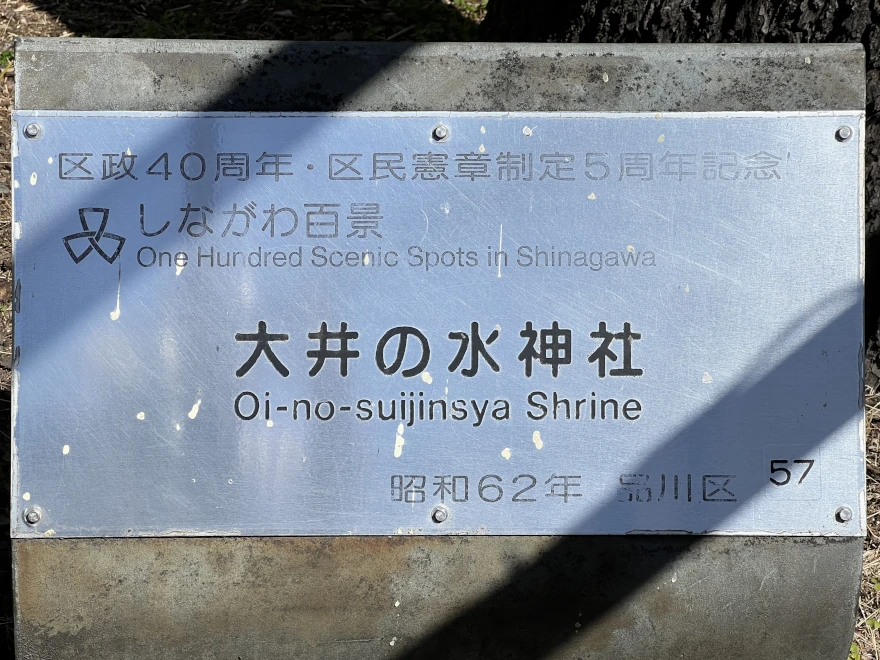Oi-no-suijinsya Shrine – Where the Waters Once Whispered
Oi-no-suijinsya (大井の水神社) is a small shrine tucked at the edge of Oi Suijin Park, embraced by trees and memories. Though easy to miss, its story flows deep through the history of this once water-rich corner of Shinagawa.
🌊 Oi-no-suijinsya Origins
This shrine was founded in 1685 (Jokyo 2) by two local villagers—Sakurai Ihee (桜井伊兵衛) and Ono Chūzaemon (大野忠左衛門)—to enshrine the water deity Kuzuryū Gongen (九頭龍権現). The site marked a natural spring at the base of the Musashino Plateau. Locals depended on this spring for drinking water and agriculture, and in times of drought, they gathered to offer prayers for rain.
🌱 Yanagi no Shimizu – The Willow Spring
Because of a great willow tree that once shaded the waters, the spring came to be known as “Yanagi no Shimizu” (柳の清水). It never ran dry, even during long droughts. Farmers from surrounding villages would haul its water to their fields. The spring was also thought to cure toothaches—a belief passed down through generations.
⛩ Postwar Revival
The shrine fell into disrepair after World War II, but local residents came together to restore it. The grounds were cleared and replanted, koi were introduced into the pond, and trees like beech and fig were nurtured into a leafy canopy. Though the original spring dried up around 1975, the spirit of the place endures.
In recent years, Oi-no-suijinsya shrine has hosted the “Oi Suijin Shrine Evening of Fireflies” (大井水神社 ホタルの夕べ) every June.
The area around the shrine was known as Oi Suijin-chō (大井水神町) until 1963, and the shrine remains deeply tied to neighborhood identity. It was designated a Shinagawa Ward Historic Site in 1978 and selected for the Shinagawa Hyakkei in 1988.
🌀 Shrine Details
- Deity: Kuzuryū Gongen (九頭龍権現)
- Affiliation: Independent local shrine
- Founded: 1685 by Sakurai Ihee and Ono Chūzaemon
- Annual events: Spring and autumn seasonal prayers
- Significance: Historic water site, associated with drought relief, toothache cures, and local agriculture
🧭 Visitor Information
Address: 5 Chome-5-22 Minami-Oi, Shinagawa City, Tokyo 140-0013
Best time to visit: After rainfall or in early spring when the grove is green and peaceful
Special event: Firefly viewing evening (ホタルの夕べ), held in June annually
Admission: Free
Where is it?
| what3words | ///rocket.belly.removing |
| latitude longitude | 35.595525, 139.733169 |
| Nearest station(s) | Tachiaigawa Station (Keikyū Line) Ōmori Station (JR Keihin-Tōhoku Line) |
| Nearest public conveniences | Available in nearby Oi Suijin Park |
Show me a sign.

A Hyakkei signboard is installed near the shrine’s torii. Look for it near the entrance by the path.
Withervee says…
This is one of those shrines that feels far bigger than it is. Hidden in a green pocket near the end of Oi Suijin Park, it once held a spring so revered that people carried its water home during droughts—and even believed it cured toothaches. There’s no flowing water now, but the spirit of Suijin, the dragon-headed water deity, lingers in the quiet grove and the koi pond.
Some visitors still stop here to pray for peace, for rain, or simply for a break from Tokyo’s relentless pace. Cats sometimes perch on the rocks. Lanterns hang quietly among trees. It’s not just a shrine—it’s a pause button in local time. Walk slow, breathe deep, and offer a thought to the god of water and all the life it nourishes.
A sign within the shrine says the following:
品川区指定史跡
大井の水神
所在地:品川区南大井五丁目五番二十二号
指定:昭和五十三年十二月二十三日
この台地の末端から水が湧き出ていた。地下水はかつては村民が水を汲み農業用水に利用していたため、龍頭を祀ったのが始まりで水神とされた。
願主は大井村の桜井伊兵衛・大野忠左衛門といわれ、貞享二年(一六八五)に願い出たと伝えられる。
また本社は当初芝の芝口、日照の山とよばれるこの地にあったという。
明治以降、祭神は水波乃売命に変わったが、昭和五十年頃まで水が湧出していた。
これは、都市化が進んだこの地域に、農村であった頃の水の供給源であり、まつられたことを示す貴重な史跡である。
平成二十四年二月二十九日
品川区教育委員会
Translation:
Shinagawa Ward Designated Historic Site
Oi no Suijin (Water Deity of Oi)
Location: 5-5-22 Minami-Oi, Shinagawa Ward
Designation Date: December 23, 1978
At the end of this plateau, spring water used to well up from underground. In the past, local villagers drew the water for agricultural use. The enshrinement of a dragon-headed deity (Ryūzu) marked the beginning of this water god’s worship.
According to tradition, the shrine was established in 1685 (Jōkyō 2) by Sakurai Ihee and Ōno Chūzaemon, both residents of the Oi village.
Originally, the main shrine stood in an area known as “Hizashi no Yama” near Shibaguchi in Shiba.
After the Meiji period, the enshrined deity was changed to Mizuhanome-no-Mikoto (水波乃売命), a goddess of water. Until around 1975, the spring continued to flow.
This site is a rare and valuable historic remnant showing how water sources were once protected and worshipped in this now-urbanized region.
Date of Posting: February 29, 2012
Posted by: Shinagawa Ward Board of Education
Site Character
- Lifestyle 生活 (Seikatsu): ✔️
- Historical Significance 歴史 (Rekishi): ✔️
- Atmosphere/Natural Features 風土 (Fūdo): ✔️
Who in their right mind would vote for this?
- Local historians
- Shinto practitioners
- Nature and waterway lovers
- Peace seekers
- Toothache sufferers
Further reading
Ōi Suijin Town Association in Shinagawa Ward – Oi-no-suijinsya Shrine
While you’re there…
Walk along the road toward Oi Suijin Park or explore the history of execution grounds at Suzugamori.
Previous
56: Shinagawa Kumin Park

